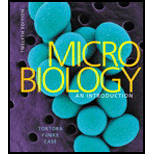
Microbiology: An Introduction
12th Edition
ISBN: 9780321929150
Author: Gerard J. Tortora, Berdell R. Funke, Christine L. Case
Publisher: PEARSON
expand_more
expand_more
format_list_bulleted
Question
Chapter 21, Problem 3CAE
Summary Introduction
Case summary:
A confirmed case of influenza who was hospitalized later developed respiratory distress. The symptoms included fever, rash, and low blood pressure. The respiratory secretions showed Staphylococcus aureus in culture. The etiological agent for the above mentioned symptoms is S. aureus and the relationship is discussed below.
Characters of the case:
- The young teenager hospitalized with influenza
- The influenza further leads to complication
- The patient develops respiratory distress
- S. aureus is responsible for this complication
Expert Solution & Answer
Want to see the full answer?
Check out a sample textbook solution
Students have asked these similar questions
Patient X is a 66-year-old man who presented with anaphylaxis after taking Tetracycline. Two days after initiating tetracycline, the man developed rashes. On the day of admission, the patient has the difficulty of breathing.
Question: What is the date of admission if the patient takes tetracycline on October 1, 2000?
104) The person known to history as "Typhoid Mary" was identified by public health officials as a source of typhoid fever, although she reported she had never had typhoid fever. Which of the following is the most accurate description of her in this scenario?
A) contact carrier
B) human carrier
C) reservoir
D) both a human carrier and a reservoir
E) a reservoir but not a carrier
Please explain the difference between bacteraemia and septicaemia.
Can the presence of toxins, fungi or viruses in the blood also be called
septicaemia?
Chapter 21 Solutions
Microbiology: An Introduction
Ch. 21 - Discuss the usual mode of entry of bacteria into...Ch. 21 - What bacteria are identified by a positive...Ch. 21 - Prob. 3RCh. 21 - Complete the table of epidemiology below.Ch. 21 - Why do some states require a test for antibodies...Ch. 21 - Prob. 6RCh. 21 - Prob. 7RCh. 21 - Prob. 8RCh. 21 - Prob. 9RCh. 21 - Prob. 10R
Ch. 21 - Prob. 1MCQCh. 21 - Prob. 2MCQCh. 21 - Prob. 3MCQCh. 21 - A 12-year-old boy had a fever, rash, headaches,...Ch. 21 - A patient has conjunctivitis. If you isolated...Ch. 21 - You microscopically examine scrapings from a case...Ch. 21 - Prob. 7MCQCh. 21 - Prob. 8MCQCh. 21 - Prob. 9MCQCh. 21 - Prob. 10MCQCh. 21 - A laboratory test used to determine the identity...Ch. 21 - Prob. 2ACh. 21 - Prob. 3ACh. 21 - Prob. 4ACh. 21 - Prob. 1CAECh. 21 - Prob. 2CAECh. 21 - Prob. 3CAE
Knowledge Booster
Similar questions
- Bacterial (e.g., S. pneumoniae) pneumonia is commonly manifested by a cough productive of sputum, whereas with atypical (e.g., Mycoplasma pneumoniae) pneumonia, the cough is usually nonproductive or absent. Explain.arrow_forwardYou are caring for a 5-year old with lethargy and a fever of 103 F. Lungs sound are clear but the child complains of a very sore throat prior to going to bed. During transport, you observe copious secretions. Which of the following do you suspect? A) Pnemonia B) Croup C) Bacterial Tracheitis D) Epiglotisarrow_forwardMake a comment on Antimicrobial Resistance (AMR), regarding the impact on the treatment of infections caused by bacteria with AMR and future consequences of this "Silent Pandemic". 7 line paragrapharrow_forward
- Name three antimicrobial substances found in saliva.arrow_forwardPatient X is a 66-year-old man who presented with anaphylaxis 3 days after taking Tetracycline. Two days after initiating tetracycline, the man developed rashes. On the day of admission, the patient has the difficulty of breathing. Question: What is the date of admission if the patient takes tetracycline on October 1, 2000?arrow_forwardThis is a 14-year-old female patient who, after playing volleyball at school, begins with respiratory distress. She is taken to a nearby emergency, mistreated and sent to her house because she improved immediately.Her background is: frequent sinusitis and flu, she is also allergic to Penicillin.Sat. 97% 02 FR 28rper min. FC: 99lat.pormin. a) Possible diagnosesb) The handling in the Emergency was correct, explain why.c) What would be the corresponding studies to arrive at the diagnoses that you indicated?d) What therapeutic measures would you implement?arrow_forward
- refer to the diagram left hand side is Tetracycline and right hand side is ampicillin. please help to describe the observation and explain these two antibiotics are sensitive or not.arrow_forwardFor each of the following antibiotics, identify its mechanism of action. Antibiotic Mechanism of Action Erythromycin Aminoglycosides Linezolid Sulfonamides Penicillins Vancomycin Polymyxins Rifampin Quinolonesarrow_forwardIf the diagnostic tests reveal the presence of high numbers of staphylococci, discuss the probable conditions that are producing the given signs and symptoms. (See Clinical Signs and Symptoms of Infection.)arrow_forward
- A 31-year-old female presents with fever, intermittent severe pain in the left upper quadrant of her abdomen, and painful lesions involving her fingers. History reveals that she had intermittent mild pain in the left upper quadrant of her abdomen over the last few months and reveals that she had acute rheumatic fever as a child. At the present time one of three blood cultures submitted to the hospital lab grows out a particular organism. What is the most likely causative agent? a. Streptococcus Pyogens. b. Streptococcus pneumonia. c. Staphylococcus epidermidis. d. Viridans streptococci.arrow_forwardResistance to antimicrobial agents is more commonly seen in hospital-acquired infections with enteric bacteria than in community-based infections with the same species. Explain why this is so.arrow_forwardListeria monocytogenes Review some common causes of meningitis by placing them in the correct microbial categories. Coccidioides immitis Acanthamoeba Viral Meningitis Protozoan Meningitis Bacterial Meningitis Fungal Meningitis Cryptococcus neoformans Herpes simplex Streptococcus pneumoniae Наеторhilus influenzae West Nile Neisseria meningitidis Naegleria fowleriarrow_forward
arrow_back_ios
SEE MORE QUESTIONS
arrow_forward_ios
Recommended textbooks for you
